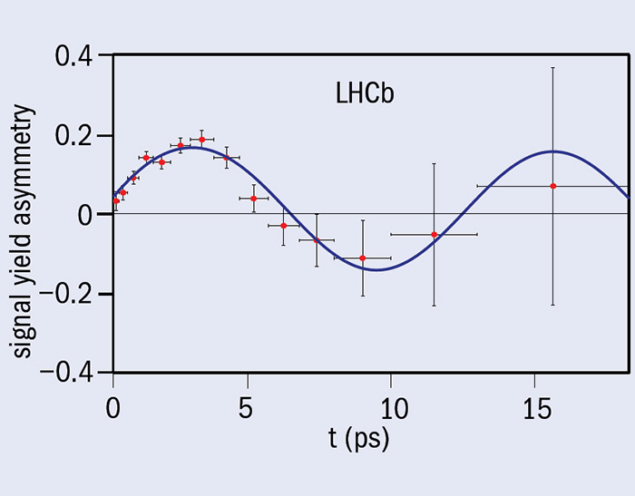
The “golden channel”, B0 → J/ψ K0S, allows for a clean determination of the angle β of the triangle that represents the unitarity of the Cabibbo–Kobayashi–Maskawa (CKM) quark-mixing matrix. The matrix describes CP violation in the Standard Model as the result of a single irreducible complex phase. Its unitarity relates observables of many different measurements to a small number of parameters, thereby allowing for a stringent test of the electroweak sector of the Standard Model.
The CP violation in B0 → J/ψ K0S arises from the interference of the direct decay and the decay after B0–B0 oscillation. It manifests itself as an asymmetry between the decay rates of B0 and B0 mesons that depends on the decay time, t:

Here, S and C are the CP observables, and Δm/2π is the frequency of the B0–B0 oscillation. Because the decay is dominated by a single decay amplitude, C is expected to vanish and S can be identified as sin 2β.
The LHCb collaboration has now analysed the full data set from Run 1 of the LHC, comprising 114,000 reconstructed and selected B0 → J/ψ K0S decays (LHC Collaboration 2015). The analysis relies on identifying the initial flavour of the B meson, i.e. whether it was produced as a B0 or a B0 meson. This so-called flavour tagging exploits event properties that are correlated to the production flavour of the B meson. The flavour identification succeeds for 41,560 B0 → J/ψ K0S decays, and is correct in 64% of the cases.
The LHCb measurement yields S = 0.731±0.035 (stat.) ±0.020 (syst.), and is in good agreement with the value expected from CKM unitarity when excluding direct measurements of sin 2β 0.771+0.017–0.041 (Charles et al. 2015). Despite the challenges of the hadronic environment of the LHC, the result is at a similar precision to the B0 → J/ψ K0S analyses of the BaBar and Belle experiments at the PEP-II and KEKB B factories.
BaBar and Belle established CP violation in the B0 meson system by observing it in B0 → J/ψ K0S decays for the first time in 2001. They have since contributed with measurements of sin 2β leading to a very precise world-average value of 0.682±0.019 (Heavy Flavor Averaging Group 2014). Although LHCb’s new result is not yet as precise, it notably demonstrates that the experimental challenges are met, and that a similar precision will be achievable with the data to be collected in the LHC’s Run 2. LHCb will then contribute significantly to our knowledge of this fundamental parameter, and will allow for more stringent tests of CKM unitarity.








